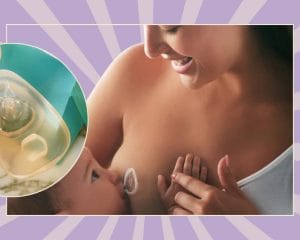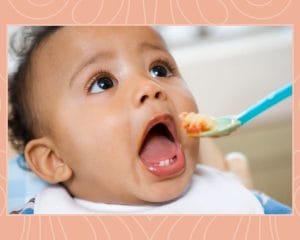Actually, you don’t have to pump and dump

Trendsetter Images/Shutterstock
Current AAP guidelines state that up to one drink per day is not known to be harmful to the infant.
This story was originally published on April 28, 2019. It has been updated.
Table of Contents
Cheers! You just brought a tiny human into the world. You’re finally starting to settle into a routine and feeling ready to celebrate with that champagne you meant to have the day the baby was born—but were too tired to open for those first couple of months.
Before you toast, you check a parenting forum to see how long you should wait to breastfeed the baby after enjoying your bubbly. You don’t want your baby getting drunk or getting sick. So, just to be safe, you skip the second glass and pump out the “toxic” milk. As you pour that liquid gold down the drain, you decide not to drink again until your baby weans. But the truth is: There is no need to pump and dump.
You don’t have to pump and dump
The most recent breastfeeding recommendations from The American Academy of Pediatrics (AAP) underscores this fact.
“Moderate alcohol consumption by a breastfeeding mother [up to 1 standard drink per day] is not known to be harmful to the infant, especially if the mother waits at least 2 hours after a single drink before nursing or expressing milk to be fed to the infant.”
There’s no need to pump after drinking to avoid passing alcohol to your infant. The only reason to “pump and dump” after drinking alcohol is due to engorgement when you can’t easily feed the baby or store the milk.
Related: AAP now recommends breastfeeding beyond age 2 due to benefits for both baby and mother
Guidelines for drinking while breastfeeding
It’s OK to enjoy a drink while breastfeeding. Here’s what you need to know about safe alcohol use while you’re nursing, according to the AAP:
- Up to one standard drink per day (12 ounces of beer, 5 ounces of wine, or 1.5 ounces of liquor) is not known to be harmful to the breastfeeding infant
- Wait at least two hours after a drink before nursing or pumping milk for your baby
- Alcohol concentrations in breast milk are highest 30 to 60 minutes after drinking
- Moderate alcohol intake does not appear to affect breastfeeding duration
- Drinking more than two standard drinks daily is discouraged
It is important to note many medical providers recommend that women do not breastfeed if they are feeling the effects of the alcohol. If you feel buzzed, there is some alcohol in your breastmilk—and it is probably best if your baby does not drink that milk. We simply don’t know enough about the impacts, so we can’t say with certainly that it’s fine. But waiting 2 hours after finishing your drink means that your body has processed the alcohol from your blood and broken it down, and it won’t be present in your breast milk, negating the need to pump and dump.
Related: Can I drink alcohol if I’m breastfeeding?
“I think a lot of women think that they have to pump the alcohol out of their bodies before they feed their baby, which is just not the case. If it’s out of your bloodstream, it’s out of your milk,” says Diana Spalding, CNM, a midwife and a member of Motherly’s expert panel.
The real question to answer, then, is not should women pump and dump, it’s why do women believe they should?
Why the pump and dump myth persists
The practice of “pump and dump” may be so prevalent because the term is so memorable. Any headline that invokes “pump and dump,” even to negate the practice, may unintentionally reinforce it, because a rhyming verb phrase is hard to forget.
Another reason for the persistence of “pump and dump” may be that the science debunking it is complicated.
That’s why review articles, which examine all of the findings a scientific community has come to about a particular topic, can be enlightening. They weigh the different findings against each other and offer a useful summary of the literature so far.
Related: Is it safe to get a tattoo while breastfeeding?
One such review appeared in a 2013 issue of Basic and Clinical Pharmacology & Toxicology. One of the more interesting findings of the review was the confirmation that babies consume less milk when their mothers drink. The current theory, while not yet well-understood, is that alcohol consumption slows the body’s production of prolactin and oxytocin, which regulate milk production and ejection. But as for drinking while nursing, authors conclude that:
“It appears biologically implausible that occasional exposure to such amounts should be related to clinically meaningful effects to the nursing children. The effect of occasional alcohol consumption on milk production is small, temporary and unlikely to be of clinical relevance. Generally, there is little clinical evidence to suggest that breastfed children are adversely affected in spite of the fact that almost half of all lactating women in Western countries ingest alcohol occasionally.”
It’s also possible that the “pump and dump” is tied to pervasive judgment of mothers in our culture. A look at where the term comes from can help us unpack these judgments. The term “pump and dump” did not initially apply to nursing mothers, but instead to the financial industry, where to “pump and dump” meant to fraudulently advertise a stock to artificially inflate its prices and then sell off one’s own shares at a tidy profit. This nefarious purpose is echoed in other meanings of “pump and dump,” among them gasoline theft or a one-night stand.
Related: The pressure to exclusively breastfeed is hurting mothers’ mental health
When the breastfeeding “pump and dump” is put in the context of these other meanings, we see that all of them imply judgment. In the stock market, he who pumps and dumps is defrauding innocent investors for his own gain. In dating and relationships, he who pumps and dumps is committing a similar type of fraud, albeit for a shorter-term gain.
What about the woman who pumps and dumps? She, too, is perceived to have put her child in harm’s way by focusing on her own pleasure (the glass of wine) over her baby’s health. Pumping and dumping breast milk is almost a penance for the woman, who is perceived to have acted shamefully.
Of course, the other pumpers and dumpers have committed a far worse act than the breastfeeding mother. In fact, the greater sin may be in throwing out the milk, which has less alcohol than kefir, kombucha, juice, or homemade bread.
Calculating when it’s safe to drink and breastfeed
Many of the articles above—including the scientific review article—mention Motherisk’s nomogram for breastfeeding mothers, which can be used to calculate roughly how many hours and minutes it will take for drinks to be cleared from her blood (and thus, her breast milk).
The problem with such a tool (aside from the fact that it only goes up to 210 pounds) is that it sets as its goal having absolutely no alcohol in the mother’s blood, and there is, as yet, no scientific evidence to support this is necessary. It’s this kind of rounding down to “no safe amount” that leaves women drinking a glass of wine and then thinking they should pull out their pumps.
Here is Spalding’s take on it:
“The only time I encourage pumping and dumping is to prevent engorgement (and the sequel of problems that can come from it). So, say you are out at a wedding enjoying a margarita or four. Great! (But please call an Uber.) If you don’t empty your breasts, you will likely become engorged. And routinely skipping feedings can lower your milk supply as well.
“Instead, take a dancing break and pump. Now, that pumped milk will have some alcohol in it. To be extra safe, instead of bringing that milk home for your baby to drink, dump it. When you’re all sobered up tomorrow, your baby will have perfectly ‘sober’ milk to drink, and your breasts will thank you for the previous night’s emptying.”





































